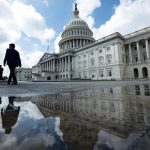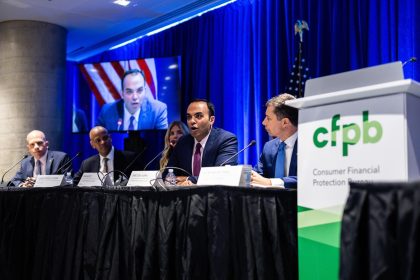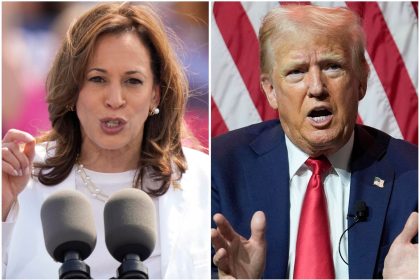The Federal Reserve left interest rates at a 23-year high for the seventh consecutive meeting and new projections showed that officials are now expecting to cut interest rates just once this year, as they await more clues that inflation is making its way back toward their goal.
The decision means that the Federal Open Market Committee (FOMC)’s key benchmark federal funds rate will stay in its current target range of 5.25-5.5 percent, where it’s held since July 2023.
Consumers will also continue seeing historically pricey borrowing costs on everything from credit cards and auto loans to mortgage rates and home equity loans. Yet, they can also keep taking advantage of the highest yields on savings accounts and certificates of deposit (CDs) in more than a decade.
Policymakers were in a hurry to lift borrowing costs to conquer red-hot inflation after the pandemic, raising interest rates 11 times across 12 meetings at the fastest pace in 40 years. Yet, when it comes to the way back down, officials are taking their time, as inflation gives mixed signals and the U.S. economy remains resilient.
But Fed officials have a tricky job ahead of them. Proponents of maintaining high interest rates can find plenty of data to back up their position, while those advocating for rate cuts are likely able to spot vulnerable areas in the financial system, too.
Supporting the high-rate camp, employers added a surprising 272,000 new jobs in the month of May, unemployment remains historically low and inflation is still well above the Fed’s 2 percent objective, thanks to stubborn rent inflation. At the same time, unemployment officially hit 4 percent in May for the first time since January 2022, an undeniable increase from the half-century low of 3.4 percent. The latest consumer price index (CPI) report also showed that both goods and services prices are starting to decline. Over the past month, inflation was flat for the first time since July 2022.
While fresh projections on the economy and interest rates showed that the new median estimate of rate cuts for 2024 moved down from just three to just one, policymakers appear divided. Seven officials currently expect one cut, while eight are penciling in two cuts. Four, meanwhile, expect to keep rates steady.
Interest rate cuts aside, borrowing costs are bound to stay painfully high for those who carry high-interest debts or are in the market for a big-ticket purchase.
Interest rates aren’t likely to come down soon enough, or fast enough, to provide meaningful relief to borrowers. Utilize zero-percent credit card balance transfer offers, shop around for lower fixed-rate personal loans and home equity loans, and channel as much income as possible toward paying down this debt as quickly as possible.
— Greg McBride, CFA , chief financial analyst for Bankrate
The Fed’s rate decision: What it means for you
Savers
Lower rates mean annual percentage yields (APYs) at the nation’s highest-yielding online banks eventually might not be a flashy 5 percent. Yet, savers should think about their returns on an inflation-adjusted basis — and the gap between your yield and inflation should continue to grow if both prices and borrowing costs decline.
Bankrate’s rankings of the 10 best high-yield savings accounts for June are all offering a yield higher than the current inflation rate of 3.3 percent. They range from a low of 5 percent to a high of 5.3 percent. That’s also nearly nine times higher than the yield at the average U.S. bank and 400-500 times higher than at some of the nation’s largest depository institutions, Chase and Bank of America.
The best part is that many of the nation’s highest-yielding banks come with Federal Deposit Insurance Corp. (FDIC) protections, making it possible for savers to safely earn a market-like return on their emergency savings within certain limits. A $10,000 balance in an account with a 5 percent APY would yield a saver $500 in just a year, assuming rates stay at that level, Bankrate’s savings calculator shows.
Not to mention, savers shouldn’t confuse rate cuts with the near-zero interest rates of the coronavirus pandemic-era. Borrowing costs are likely to remain high, keeping yields on savings accounts elevated.
If you have at least six months’ worth of expenses stashed away in a savings account, the one step you can take to continue reaping the benefits of higher rates — even if they do indeed decline — involves locking in a CD.
Today, the top-yielding 5-year CD can offer a depositor a 4.5 percent APY, while the best 2-year CD is paying 4.76 percent a year in interest, Bankrate data shows.
Borrowers
The main message for borrowers: Higher rates aren’t going anywhere, and even rate cuts likely won’t be enough to bail you out of the pain of high-interest debt.
Americans with credit card debt should try to rid themselves of it as quickly as possible. One solution to speeding up your debt repayment: using a balance-transfer card. Bankrate’s picks of the best offers on the market are currently advertising a 0 percent introductory annual percentage rate (APR) for as long as 21 months. You’ll need to have a debt pay-off plan, but transferring your balance could save you hundreds, if not thousands, of dollars in the long run — even if it comes with a fee.
Borrowers who’ve improved their credit score in recent months may also be able to lock in a lower interest rate. Whether you’re opening a new line of credit or looking to refinance an existing debt, be sure to compare options from at least three lenders to ensure you’re finding the best deal.
Homebuyers
Would-be homebuyers may be starting to forget the days when the 30-year fixed-rate mortgage once held below 3 percent. Since February, the key home financing rate has been holding above 7 percent — representing at least a 41 percent hit to homebuyer affordability alone.
That’s because financing $500,000 on a 30-year fixed-rate mortgage would’ve cost a borrower roughly $2,371 a month in principal and interest when rates hit a record low of 2.93 percent in Bankrate’s national survey of lenders. Today, that monthly payment has skyrocketed to $3,353, according to Bankrate’s mortgage calculator.
Mortgage rates have also been stuck above 6 percent since September 2022, Bankrate data shows.
Yet, good news could be on the horizon if inflation continues cooling. Mortgage rates are more closely tied to the 10-year Treasury yield and could even fall before the Fed starts cutting interest rates.
Just don’t expect anything close to those pre-pandemic levels. You might not even see mortgage rates fall below 6 percent, so long as economic growth holds up.
High mortgage rates are only one aspect plaguing prospective buyers. Low inventory is also keeping a floor on how low prices can go. A Bankrate analysis showed that Americans must earn at least $100,000 annually to afford a median-priced home in 22 states and the District of Columbia.
To set yourself up for homeownership in the future, prioritize paying down any debts, improving your credit score and saving for a down payment. If you can’t find a home within your price range, it might be wise to keep renting, so you can prioritize growing your income and wealth.
Investors
Interest rates may be the highest in 23 years, but that isn’t ruining investors’ moods lately. The S&P 500 has crushed multiple records so far in 2024, as market participants hope that rate cuts from the Fed aren’t that far off.
Federal funds rate futures markets offer a solid reason why investors are so optimistic. After expecting that the Fed would only be able to cut interest rates once this year, starting in November, investors have now shifted their expectations to bet on two rate cuts, beginning in September and again in December.
Another economic bogeyman could still show up to ruin the party. But if you’re investing for longer-term goals such as retirement, remember that you can play the long game. A diversified portfolio and time in the market are the best ways to protect your investments. Falling stock prices can also mark a significant buying opportunity.
When might the Fed start cutting rates? For now, it looks like sometime in the fourth quarter
Fed officials are expecting to cut interest rates fewer times this year, even after an inflation report released the morning before the decision showed that prices slowed faster than expected.
Inflation rose just 3.3 percent from a year ago and hit a three-year low when excluding food and energy prices, Bureau of Labor Statistics data showed. The number of items that are still picking up speed also declined for a third straight month.
Food prices, meanwhile, rose by the smallest amount since 2020, while goods excluding food and energy fell by the most since 2004, according to the report. Even some services, such as meals at restaurants, showed the slowest increase since 2021.
Those upbeat readings are leading some economists to expect that the Fed will err on the more aggressive side of its rate-cut estimates.
“If we continue to receive tame monthly inflation readings in the coming months, the Fed could start to cut rates in September and follow up again in December with another reduction,” says Kathy Bostjancic, chief economist at Nationwide.
Fed Chair Jerome Powell himself acknowledged that the report showed “welcome” progress while also adding that the slowdown in the job market looks akin to normalization — not weakness.
“Conditions in the labor market have returned to about where they stood on the eve of the pandemic: relatively tight, but not overheated,” he said at the post-meeting press conference. “We’ll need to see more good data to bolster our confidence that inflation is moving sustainably toward 2 percent.”
When it comes to officials’ projections for the U.S. economy in 2024, the median estimate among officials pencils in hotter inflation and no further increases in the unemployment rate.
The Fed’s new projections for 2024
- Gross domestic product (GDP): 2.1%, matching last quarter’s estimates
- Unemployment rate: 4%, matching last quarter’s estimates
- Inflation: 2.6%, up from 2.4%
- Inflation excluding food and energy: 2.8%, up from 2.6%
Fed officials are also expecting 100 basis points of rate cuts in 2025, the new projections showed.
Policymakers have long said they would be willing to cut interest rates if they saw a deterioration in the job market, yet Powell stopped short of describing what that would have to look like. But an unemployment rate higher than the Fed’s forecast or estimates among other economists would be on the list, he said.
“The May CPI released Wednesday morning is the type of inflation report we need to see more of in the months to come,” McBride says. “Other global central banks have begun to cut interest rates, but this doesn’t compel the Fed to act in a similar fashion. The U.S. economy has been more robust than overseas counterparts and inflation has been higher and a bit more stubborn in the U.S.”
Read the full article here


















